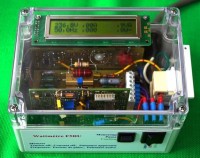Watt Meter

Hello, my article project in French concerns a power meter for AC line power consumption, also usable for DC.After some definitions and explanations about active and apparent power measurements, some voltage and current curves obtained with this meter for some different lo
After some definitions and explanations about active and apparent power measurements, some voltage and current curves obtained with this meter for some different loads are shown and commented. Consumption and consumption evolution of some devices are also given.
The schematics and a short description end the article project.
Main Features
- Maximum AC input voltage: 265 Vrms.
- Maximum DC input voltage: 375 V.
- Maximum full scale currents in three scales: 5 Arms, 0.5 Arms and 50 mArms (7.5 A, 0.75 A and 75 mA for DC).
- Max Power ratings corresponding to the 3 scales with 230 V: 1 kVA, 100 VA and 10 VA.
- Display: 4 refreshments per second, pause or one-shot.
- Voltage drop due to the insertion of the device in series with the load: max 0.5 Vrms (0.75 V for dc) max 2.5 Vrms (3.6 V for dc) if the current is higher than the selected scale.
- Measurement resolution: ~ 1/1000 of full scale for voltage and current (in fact mainly limited by noise).
- Display resolutions:
. 0.1 Vrms;
. 0.1 mA, 1 mVA, 1 mW on 50 mA/10 VA scale;
. 0.1 Hz.
- Measurement accuracy: 0.2% for voltage, ~ 1% for the current (depending mainly of the equipment used for calibration).
- Power for the operation of the device itself: 230 V 50 Hz or 12 V DC (75 mA). Attention preferably uses a battery as the source must not have an electrical connection to the mains supply.
- Measured variables: rms voltage in V, rms current in A, apparent power in VA, frequency in Hz, power factor, active power in W.
- Ability to view the minimum, maximum, average and instantaneous value of the active power of a period of 1 to 9999 s.
- Monitoring functions. An RS-232 connexion running at 115200 bauds allows getting:
. 2000 pairs of measurement points to plot the curves of voltage and current in 0.1 ms steps (like a 2-channel oscilloscope);
. 19967 values to draw the evolution in time of: the active power, the rms voltage, the rms current, frequency, the apparent power, the frequency or the power factor. These average values are calculated using a time step which my be chosen between 10 possibilities at record start (the corresponding autonomies are given in parentheses): 0.25 s (1:23), 0.5 s (2:43) 1 s (5:32), 2 s (11:05), 5 s (27h43), 10 s (2.3 days), 20 s (4.6 j), 1 min (13j), 2 min (27j), 5 min (69J ).




Discussie (4 opmerking(en))
DanyR 8 jaar geleden
DanyR 8 jaar geleden
Can you give some elaboration?
A second question: where can I find the article you are talking about?
And: Is the software of your wattmeter already published?
Thanks in advance!
DanyR 8 jaar geleden
jpgendner 8 jaar geleden
DanyR 8 jaar geleden
My second and third question remain. Thanks in advance for an answer.
ClemensValens 8 jaar geleden
paulmartin42 11 jaar geleden
phonoplug 11 jaar geleden
sixtyfive 11 jaar geleden
jpgendner 11 jaar geleden
jpgendner 11 jaar geleden
phonoplug 11 jaar geleden
paulmartin42 11 jaar geleden
jpgendner 11 jaar geleden